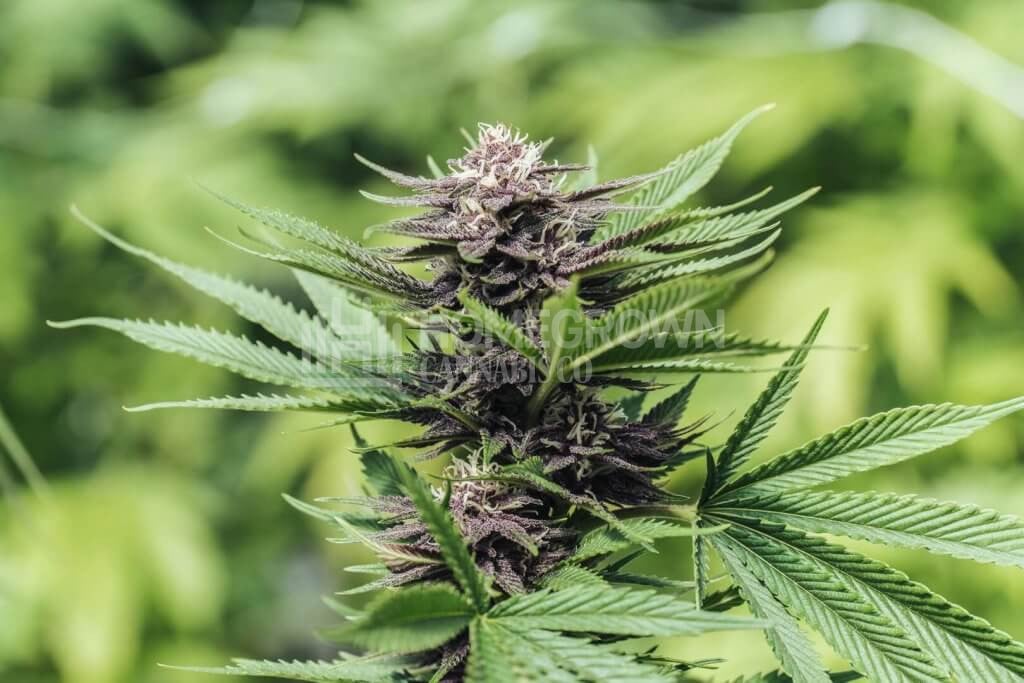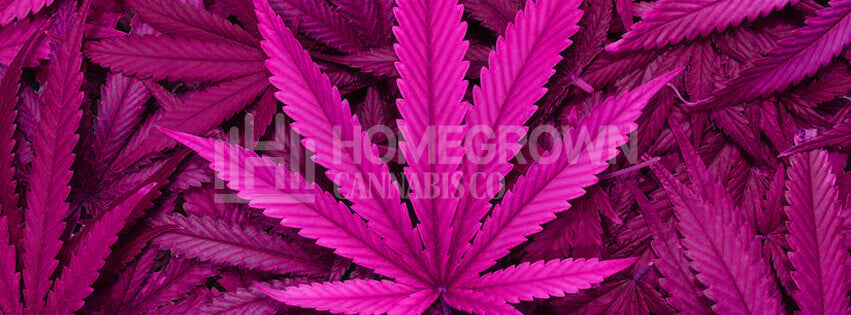Purple Weed Leaves: Why do Cannabis Leaves Turn Purple?
Have you ever wondered why some weed plants have beautiful purple weed leaves? While it may seem like a purely aesthetic phenomenon, there’s a scientific reason behind it.
Join us to explore why marijuana leaves turn purple and what it means for your plant’s health. We’ll cover the role of anthocyanins, high UV light, cold temperatures, and genetics in producing purple pigmentation.
Let’s discover the fascinating world of purple cannabis leaves.
Main causes for cannabis leaves turning purple
When you find purple weed leaves, it usually implies the plant is developing naturally. You’re probably growing one of the different purple-colored strains.
Cannabis exhibits different colors due to naturally occurring compounds known as anthocyanins. They turn the leaves, stems, buds, and other parts of the plant into various hues.
Factors such as temperature and light influence the level of anthocyanins in the plant. Colder temperatures, for instance, can cause the leaves to turn purple, along with exposure to UV rays.
While many cannabis enthusiasts consider purple plants highly desirable for their unique appearance, the color change is primarily cosmetic. It doesn’t significantly impact the flavor or effects of the final product.
The presence of anthocyanins can indicate a healthy, well-nourished cannabis plant ready for harvest. Genetics and environmental factors will ultimately determine the color change observed in the leaves and buds.

Anthocyanins
When leaves are turning purple, it may be due to the water-soluble compounds called anthocyanins. Washing purple cannabis will turn water violet.
Anthocyanins are responsible for the red, purple, and blue hues on various fruits, vegetables, and plants, including cannabis.
When cannabis plants contain high quantities of anthocyanins, the leaves and buds may develop shades of violet and blue. Sometimes, the colors may even appear dark green or black.
Anthocyanins have been used in traditional medicine for centuries by various cultures worldwide. It’s believed they treat hypertension, liver disorders, bladder problems, common colds, and infections.
There are reports of anthocyanins improving vision and blood circulation. They’re also said to be powerful antioxidants.
Whether the health benefits are due to them or the synergistic interaction with other plant compounds is still being examined. Further research is required to determine the full extent of the health benefits of these compounds.
Apart from their contribution to the color and potential medical benefits, they protect cannabis plants against environmental stressors like UV radiation and extreme temperatures.
Anthocyanins also play an essential role in pollination, as the vibrant colors they produce attract pollinators.
High UV light
When the leaves and buds turn purple, it creates a striking contrast with the green leaves. One way to achieve this phenomenon is by exposing the plant to high levels of UV light during growth.
Weed leaves turning purple in veg is normal. UV light stimulates the production of anthocyanins, the pigments responsible for the purple coloration in plants. By exposing the crop to high UV light, growers can encourage the production of these pigments.
In addition to affecting the plant’s color, high UV light also impacts the development of purple cannabis overall. While moderate exposure to UV light can boost plant growth and increase resin production, excessive exposure could lead to damage.
Balance the amount of UV light the plant receives to ensure optimal growth without causing harm.
Cold temperatures
Cold temperatures are one of the most common reasons why marijuana leaves turn purple. When the temperature drops, it affects the plant’s chlorophyll production, and the purple pigments that were previously masked become visible.
As the plant’s chlorophyll production reduces, the plant begins to break down chlorophyll molecules. This process naturally happens in fall when plants are mature and there’s less sunlight.
Not all cultivars will turn purple. The intensity of the color varies depending on the strain genetics and the environmental conditions. If you’re specifically looking for purple weed leaves, research and find a strain known for producing this trait.
Genetics
Because of its distinct appearance, purple weed is frequently connected with exotic types or purple weed strains. The primary reason for purple leaves is genetics, which makes only a few cultivars likely to exhibit this trait.
Purple Haze and Purple Kush are two famous cannabis strains that fall under the exotic varieties of purple weed. These cultivars have an eye-catching appearance and distinct flavor and scent profiles.
Most purple strains originate in regions with cooler climates, such as the Himalayan Mountains. Temperature, light exposure, and pH levels influence the color of the resulting cannabis leaves.
Even though purple plants don’t exclusively grow in colder places, their leaves tend to be purple more often when they do. In some regions, you can even find pink plants.

pH level
The pH level of the soil is among the leading causes of weed leaves turning purple.
Marijuana plants absorb more iron when the pH is lower than 6.0, giving their leaves a reddish hue. The iron isn’t as readily available at lower pH levels, causing the crops to mobilize more of it from the soil.
When the soil’s pH level is above 7.0, cannabis plants absorb more aluminum, giving their leaves a blue or purple tint. Aluminum is more available at higher pH levels, causing the crops to take up more.
While pH levels influence the color of weed leaves, they don't necessarily determine the plant’s health. Some weed strains naturally produce purple or blue leaves, even in neutral pH conditions.
Deficiencies, stress, pests, and diseases
A phosphorus deficiency produces weed plants with purple stems before the leaves turn brown and brittle.
Discolored stems, damaged foliage, and stunted growth indicate that your plants aren’t getting the necessary nutrients. Identifying and rectifying any deficiencies as soon as possible is crucial to prevent further damage to your crops.
Purple stems are sometimes caused by other factors, like stress, pests, diseases, or humidity problems. For example, botrytis and fusarium are pathogens that attack cannabis plants and produce red, brown, or slightly purple stems.
These diseases spread rapidly and can significantly delay plant growth or even lead to the death of your crops.

If you notice purple edges on weed leaves or similar looking spots, you may wonder what could cause this abnormality. A phosphorus deficiency is likely to blame.
This crucial element is necessary for plants to create energy, sugars, and nucleic acids. Young crops are especially vulnerable to developing a deficiency. In the early stages, affected leaves may appear washed-out and dark, with dark veins and lighter tissue.
As the deficiency progresses, purplish discolorations appear on the leaves, with the edges turning brown and curling downwards.
Leaf petioles may also turn purple. In the final stages, large leaf patches may become purplish-brown and die. At the same time, the remaining sections turn mottled yellowish-green.
Colder soil temperatures early in the growing season can exacerbate phosphorus deficiencies in some plants.
Fake purple weed plants
Fake purple weed is a common issue in the cannabis industry. It refers to weed buds that are artificially colored to give the illusion of purple hues.
This appearance is achieved by spraying the buds with food coloring or dyes, which can harm the consumer’s health. These practices are carried out by unscrupulous sellers who want to increase their profits by enhancing the visual appeal of their products.

Purple weed leaves - Don’t judge a strain by its color
Are strains with purple weed leaves better than green ones? It’s important to understand that various factors, such as genetics, light, and soil pH, influence the color of a cannabis plant.
While purple marijuana strains are often considered more exotic and visually appealing, the color change is primarily cosmetic. It doesn’t necessarily indicate a higher-quality product.
That being said, some purple strains are known for their unique flavor profiles and potent effects. Purple Haze and Purple Kush are two strains that have fruity and spicy flavors and relaxing and euphoric effects.
Want to grow your own purple cannabis buds? Browse our store to discover high-quality cannabis seeds from various sought after purple strains.